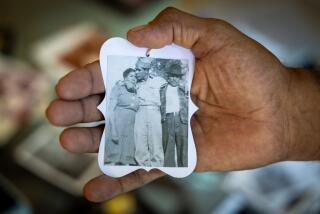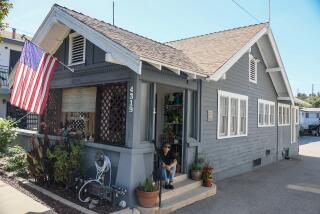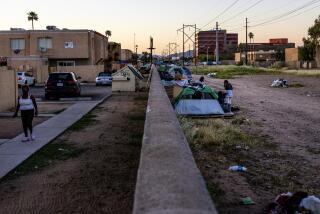Downright Divisive : Project to Put Power Lines Underground Splits Rancho P.V. Homeowners
When Rancho Palos Verdes resident Freida Sliskovich helped circulate a petition a decade ago to get overhead power lines placed underground, she thought she was doing something that most of her neighbors wanted.
“People came to my door because there was great interest in this at the time,” said Sliskovich, who lives on Daladier Drive in a 30-year-old hilly neighborhood above Western Avenue that enjoys commanding views of Los Angeles Harbor.
Sliskovich and others who favored the idea then--but have yet to see it come to fruition--say it would improve the safety and efficiency of electrical and telephone systems by eliminating overhead lines, which are subject to failure during high winds and storms.
They also envision improved views and more pleasing aesthetics as unattractive poles and transformers were removed.
While a majority of residents signed that petition, the tide had turned by the time the City Council voted three years later in 1982 to form an undergrounding assessment district of 77 homes, which would pay for the project on the city’s east side.
Majority Were Opposed
By then, the majority of owners--including some who had moved in and others who had changed their minds--were opposed to it. They contended that undergrounding was really aimed at improving views, not safety, and that many homes in the district would not benefit from the expensive project. The cost was an estimated $4,600 per home at the start of the petitioning in 1979, and it has continued to grow.
This argument remains alive today. While the City Council in April voted to form the district--commonly known as the Daladier undergrounding district--the project is on hold because of a lawsuit filed by opposing homeowners, Citizens Against Undergrounding. A lively letters to the editor campaign also is being carried on by both sides in several newspapers.
The dispute, which is unprecedented in the city, is a classic neighborhood feud that has seen the advantage flip-flop between supporters and opponents and an increase in the number of houses within the district. Both sides accuse each other of using false and inflammatory information.
The current petition is the latest of three that have been circulated, each of them leading to a lawsuit in Los Angeles Superior Court. One was appealed to the state Court of Appeal. An attempt to take the issue to the California Supreme Court was rejected.
“There is tenacity on both sides to carry this on,” said City Manager Dennis McDuffie, who said it is very unusual for assessment district controversies to drag on for so long. “You have a group of people dedicated to having undergrounding . . . and another side that is just as tenacious.”
The most recent council vote came in the face of 56% homeowner opposition, which the council unanimously overrode after concluding that the benefits of placing utilities underground outweighed the disadvantages. The council approved an expanded underground utility assessment district encompassing 92 homes on Daladier, Chandeleur, Suana and Miraleste drives, and on La Vista Verde and Avenida Corona.
According to the city, which has completed its planning and selected a contractor for the $940,000 project, about 60 utility poles between 40 and 100 feet high will be removed and lines for electricity, telephones and a future cable TV system will be put underground.
Each property owner will pay between $7,283 and $10,924 for the main utility line, depending on how much benefit the city has determined each house would gain in safety, view, general aesthetics and other factors. There will be an additional $15 to $20 per foot fee to connect homes to the main line.
Project on Hold
Public Works Director George Wentz, however, said the project is on hold because of the suit, which alleges that the project is improper because costs and benefits were misrepresented to obtain signatures on petitions, and because it was opposed by a majority of the homeowners.
Attorney Ariel Calonne, a lawyer for the city, said the suit prevents the sale of bonds to finance the project. The bonds would be guaranteed by liens on houses in the district. “If the suit succeeds, that would negate the liens, and there would be no security for the bonds,” he said.
The undergrounding fight has created a rift in which the opposing factions have found little they agree on.
“The petition itself is fraudulent,” an Avenida Corona resident, M. L. McGee, charged recently. In 1986, when the latest petition was started, petitioners and the city “deliberately low-balled the figures to get signatures.”
Wentz said official estimates ranged between $4,500 and $7,000 a home in 1986, but they climbed to nearly $15,000, he said, before the city found ways to reduce the cost to current levels.
“We were not low-balling,” Wentz said. He said the lower cost resulted from the city and utilities reducing such things as the the cost of cabling material and administrative overhead. “The costs were our best estimates at the time. We have no control over the marketplace.”
Sliskovich contends that opponents of undergrounding have been the ones who are misrepresenting the issue. She said that in every petition drive, proponents always have had more than 60% of the residents’ support until critics “came out of the woodwork” to get people to change their minds and protest.
Ralph Welch, a Daladier resident since 1966 who favors undergrounding, contends that the opposition “frightened people on fixed incomes” by telling them it could cost them each $49,000.
Could Protest
McGee also asserts that while residents were told they could protest the assessment district and try to prevent its formation, the city intended all along to override the protest.
In a letter, Bessie P. Jones of Avenida Corona asserted much the same thing, saying that proponents of undergrounding “got us to sign with the understanding that, when we found out the cost, we could withdraw our signatures. We did that, and look what happened.”
Under a state law governing assessment districts, a four-fifths majority of the council may override a protest by a majority of property owners if at least 60% of the owners initially supported it in a petition. Officials said all petitions filed for the Daladier district contained 60% majorities prior to protests being registered.
View Enhancement
McGee asserts that there is no evidence that the utility system will be safer or more efficient if it is placed underground. “It boils down to view enhancement for some,” he said.
Avenida Corona resident Kathleen E. Countryman disagrees, citing a January fire in a home next door to hers. In a letter, she said the fire downed power lines. “After this experience, we do not understand how anyone . . . could oppose undergrounding,” she wrote.
Countryman, a 10-year resident of the area, said in a recent interview: “Our phone has been out and our power has been out (enough times) to make it noticeable.”
Michael Smith, Palos Verdes Peninsula area manager for Southern California Edison Co., said the present system poses no more dangers than any other overhead system. But he said an underground system would have less exposure to what he called the “vagaries of Mother Nature” and would provide aesthetic benefit and fewer outages.
Benefits Outweigh Protest
Councilman Mel Hughes said the council voted to form the district despite strong protest because it believes the benefits of undergrounding outweigh the protests.
Calling the existing system inadequate, he said, “This is an opportunity to take it out, install a new one, and get view enhancement. At some point, you have to exercise what you feel is a reasonable decision. We did that, and it’s not always popular.”
Rather than ignoring the will of residents, as some critics charge, Hughes said the city “has listened more to this issue than any other issue in the city. It has been going on for 10 years.”
Sliskovich said proponents of undergrounding were gratified when the district finally was formed because “we worked hard . . . we deserve to have what we asked for.”
But it is not a happy victory. “This has torn neighbor against neighbor,” she said. “We did not pop any Champagne.”
BATTLE LINES OVER POWER LINES The underground utility district that encompasses 92 houses on the east side of Rancho Palos Verdes has a complicated 10-year history, say residents and city officials.
The initial petition to underground utilities in the area was circulated in 1979, though it took three years before it was acted on by the City Council. More than 60% of the property owners in the district, which then encompassed 77 houses, signed petitions supporting the proposal.
Opponents filed a “protest list” of property owners who were against the project. At the council meeting to consider the creation of the district, opponents claimed to have a majority, and asked to add to the protest list. The council refused to allow the addition of any names to the protest list, though it did permit withdrawals.
The protesting residents sued. A Los Angeles Superior Court ruled that a majority protest did not exist. In addition, it said that had there been a valid majority protest, the council’s four-fifths vote was sufficient to override it.
The residents went to the state Court of Appeal, which ruled in their favor in 1984. It held that there had been a majority protest and invalidated the council vote because of that procedural error.
The city appealed to the California Supreme Court, which refused to hear the case.
After another petition drive in 1985, the council once again approved creation of the district. Again, residents sued in Superior Court. The district was abandoned because other homeowners sought to expand the district to include their houses.
A year later, the most recent petition was circulated. It led to the April council vote, approving the 92-house district.
More to Read
Sign up for Essential California
The most important California stories and recommendations in your inbox every morning.
You may occasionally receive promotional content from the Los Angeles Times.










